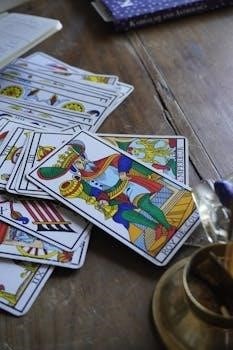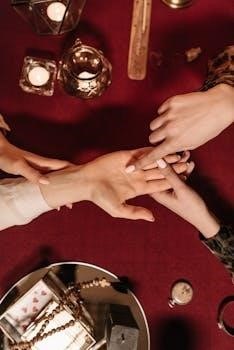Emily Croy Barker’s debut novel, The Thinking Woman’s Guide to Real Magic, introduces a unique blend of classic fairy tale elements with a modern twist. This portal fantasy follows a woman’s journey into an alternate world. The narrative is an imaginative synthesis of classic stories.
Overview of the Novel
The Thinking Woman’s Guide to Real Magic centers on Nora Fischer, a struggling PhD student who accidentally enters a magical world. This novel combines elements of fantasy, romance, and social commentary, creating a unique reading experience. It is a portal fantasy that takes readers on a journey into an alternate reality. The story involves fairies and magicians. The narrative is a blend of classic fairy-tale intimacy with a modern edge. The plot is considered marvelous with clever dialogue and complex characters. It has a dark twist, and cinematic storytelling.
The Protagonist⁚ Nora Fischer
The story revolves around Nora Fischer, a PhD student who desires a different life. She finds herself transported to a magical world, setting the stage for her adventures.
Nora’s Mundane Life and Struggles
Nora’s life is far from extraordinary, she is a struggling graduate student grappling with her stalled dissertation. She is also dealing with a relationship that is not very fulfilling. Nora feels a deep sense of dissatisfaction, and she yearns for something more. This ordinary existence provides a stark contrast to the magical world she later encounters, highlighting her desire for change. This all gives her a very open mind.
Nora’s Accidental Entry into a Magical World
Nora’s entry into the magical world is not a grand, planned event, but rather an accidental stumble. She quite literally wanders into this alternate reality. This unexpected transition thrusts her into a realm where magic is real and where everyone seems glamorous. Her sudden displacement from her mundane life propels the narrative, setting the stage for her journey of adaptation and discovery in this new, fantastical place.

The Magical World
The novel presents a wonderfully imaginative world of illusion and real magic, where fairies and magicians exist. It is an alternate reality, a place where the rules of the mundane world do not apply.
Description of the Alternate Reality
In The Thinking Woman’s Guide to Real Magic, the alternate reality is depicted as a glamorous, almost dreamlike place, where life seems to be one long party. This world is a stark contrast to the mundane life Nora experiences initially. It’s a realm where magic is tangible and woven into the fabric of existence, creating a fantastical atmosphere that is both alluring and potentially dangerous. The world is medieval-like with a deliciously dark twist, making it a unique space for Nora’s adventures.
The Nature and Rules of Magic
The magic in The Thinking Woman’s Guide to Real Magic is presented in a cogent and lucid manner, never becoming dull to read. The explanations of how magic functions are smooth and engaging. It’s a system that requires skill and learning, and is not just a whimsical force. The rules of magic are explored throughout the narrative, and are integral to the plot. It’s a world where magic can be both a source of power and a potential danger, with its own set of limitations.

Themes Explored
The novel explores themes of social commentary, and romance. The book also touches on the desire for a different life. The story features the importance of learning and love. It also incorporates elements of illusion and reality.
Social Commentary and Relevance
Through Nora’s experiences, the novel offers a subtle social commentary. Her initial struggles in academia and her personal life reflect modern anxieties. The stark contrast between her mundane existence and the glamorous magical world highlights societal expectations and the desire for escape. The book examines the allure of a different reality. Barker’s narrative provides a lens through which to view contemporary issues. It also invites readers to consider their own yearnings for change and self-discovery.
Romance and Relationships
The novel explores the complexities of relationships through Nora’s interactions in both the mundane and magical realms. Her initial relationship provides a backdrop for her desire for something more. Her new connections within the alternate world offer a romantic element. These relationships add depth to the narrative, and also allow exploration of different dynamics. The book showcases the importance of personal connections and how they shape individual journeys. Love and relationships are explored as a key part of Nora’s experience.
Literary Comparisons and Influences
This novel draws comparisons to works by Deborah Harkness and Lev Grossman. It blends classic fairy-tale intimacy with modern fantasy. It is a synthesis of stories that delighted in childhood and inspired in adulthood.
Similarities to other Fantasy Works
Readers have noted similarities between The Thinking Woman’s Guide to Real Magic and other contemporary fantasy novels. The novel shares thematic and stylistic elements with works by authors like Deborah Harkness and Lev Grossman. Specifically, the portal fantasy aspect is reminiscent of Grossman’s The Magicians, while the romantic and magical elements are akin to Harkness’s style. The narrative explores similar tropes of a hidden magical world intertwined with a mundane reality, which appears in many fantasy works.
Influence of Classic Fairy Tales
The Thinking Woman’s Guide to Real Magic draws heavily from classic fairy tale traditions, incorporating familiar archetypes and motifs. The narrative has been described as having the intimacy of a classic fairy tale, with a dark twist added. The novel weaves in elements of enchantment, magical realms, and characters that evoke traditional folklore. This blending of the familiar with modern sensibility creates a unique reading experience, appealing to those who appreciate the timeless magic of fairy tales. It is a synthesis of childhood stories and novels that inspire adults.

Critical Reception
The novel received praise for its imaginative plot and strong female protagonist. Some reviewers noted occasional stumbles in characterization. It was also called a breezy and fun contemporary fantasy by critics.
Positive Reviews and Praises
Critics have lauded The Thinking Woman’s Guide to Real Magic for its clever dialogue and complex characters, noting it as a marvelous plot. The novel is praised for its imaginative world-building, blending classic fairy-tale intimacy with a modern sensibility. Reviewers highlighted the book’s wry humor and wonderfully clever literary references. It is seen as a sparkling romantic adventure, with comparisons to popular fantasy works. The unique blend of magic and reality was appreciated by many readers.
Criticisms and Shortcomings
Some critiques of The Thinking Woman’s Guide to Real Magic point to occasional stumbles in characterization. Reviewers noted that the initial part of the book can feel like the author is feeling her way around the world, resulting in a somewhat slow pace. It has been described as a quick read, but not one that fully immerses the reader. Some found the plot not particularly complicated, suggesting it may be better suited for light reading, or a younger audience.
Series Information
The Thinking Woman’s Guide to Real Magic is part of a book series by Emily Croy Barker. The series includes a sequel titled How to Talk to a Goddess, continuing Nora’s magical adventures.
The Thinking Womans Guide to Real Magic Book Series
The series begins with The Thinking Woman’s Guide to Real Magic, a novel that introduces readers to Nora Fischer’s unexpected journey into a magical world. This first book establishes the core characters, the rules of magic within the alternate reality, and the initial challenges Nora must navigate. The series, with its imaginative world and clever dialogue, offers a blend of classic fantasy with modern sensibilities. The book series is known for its complex characters.
Sequel⁚ How to Talk to a Goddess
The sequel to The Thinking Woman’s Guide to Real Magic is titled How to Talk to a Goddess. This continuation of Nora’s story further develops the magical world introduced in the first book. It delves deeper into the intricacies of the magic system and the challenges faced by Nora. The sequel promises to build upon the themes and characters established in the first book. This book expands the world of the series.

The Author⁚ Emily Croy Barker
Emily Croy Barker is the author of The Thinking Woman’s Guide to Real Magic and its sequel, How to Talk to a Goddess; Her debut novel introduces readers to a world of magic.
About Emily Croy Barker
Emily Croy Barker is the author behind the imaginative fantasy novel, The Thinking Woman’s Guide to Real Magic, which marks her debut in the literary world. Following the success of her first book, she continued to explore the magical universe with its sequel, titled How to Talk to a Goddess. Barker’s work demonstrates a unique ability to blend classic fairy tale tropes with modern storytelling techniques, creating captivating narratives. Her writing style is known for its clever dialogue and complex characters, engaging readers in both whimsical and thought-provoking adventures.
Audience and Readership
This novel appeals to readers who enjoy magical fantasy adventures with strong female protagonists. Fans of portal fantasy and those who appreciate classic fairy tale elements will find this book enjoyable.
Target Audience for the Novel
The Thinking Woman’s Guide to Real Magic is crafted for readers who appreciate a blend of modern fantasy with classic fairy tale undertones. It particularly targets those who enjoy stories featuring strong female leads navigating magical worlds. Those who like a dash of romance and social commentary woven into their fantasy will be drawn to this book. Readers who are familiar with authors like Lev Grossman or Deborah Harkness may find this novel particularly appealing. The novel also suits those looking for an engaging yet easy read;
Overall Impression
The Thinking Woman’s Guide to Real Magic is an imaginative story offering a light, quick read with an appealing female protagonist. It blends classic and original elements, creating an enjoyable fantasy escape.
Final Thoughts on the Story
The Thinking Woman’s Guide to Real Magic offers a unique blend of classic fairy tale and modern fantasy, making it a compelling read for those who enjoy portal fantasies. While some may find the plot simple, it’s an imaginative tale with clever dialogue and complex characters. Its blend of romance and social commentary adds to its appeal. Though it might not be completely immersive for some, it provides a light and fun escape. It’s a story that sparks imagination and offers a satisfying conclusion to the initial chapter of Nora’s journey.


